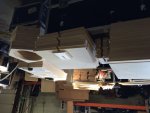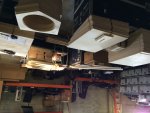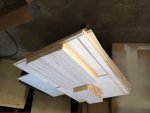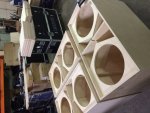Re: No compromises front loaded double 18” cab
The biggest advantages it gave me was a smaller front baffle area and greatly stiffened up the side walls of the cabinets.
I did not have any measurement gear back then-but the results I got were impressive-as compared to the cabinets that I previously built using circular ports-using the same wood (13 ply baltic) and the same drivers.
I don't know if it was the shape of the port-or the additional bracing on the side walls (most likely) or the fact I was able to get drivers closer together (not usch a big deal at those freq)-but I was happy with the results.
Take that for what it is worth.
I was building my cabinet back in the 90s with triangular ports (as in this build), long before anybody else was doing it (that I was aware of).Hey Luke,
Nice work on the build.
I'm curious about the port design. Based on the link posted earlier in this thread that related aerodynamic theory and especially boundary layer friction to high power port design, your port with the different cross sections top, middle and bottom may not behave consistently. Since the boundary layer is going to affect the narrow center section of the port much more so than the top and bottom, I wonder if the ports effective tuning is going to shift upwards with power. Probably all ports exhibit a change in effective tuning at different air velocities, but this design may exaggerate that behavior.
I'm curious what your testing reveals, but a pencil sketch on napkin application of the theory indicates the best port cross section for a high power application is a circle, as it has the least surface area for a given internal area.
In either case, nice woodworking. Let us know how they perform.
Ciao
Simon
The biggest advantages it gave me was a smaller front baffle area and greatly stiffened up the side walls of the cabinets.
I did not have any measurement gear back then-but the results I got were impressive-as compared to the cabinets that I previously built using circular ports-using the same wood (13 ply baltic) and the same drivers.
I don't know if it was the shape of the port-or the additional bracing on the side walls (most likely) or the fact I was able to get drivers closer together (not usch a big deal at those freq)-but I was happy with the results.
Take that for what it is worth.




